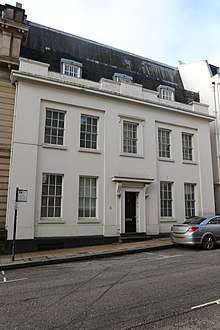Charles Edge (architect)
Charles Edge (13 October 1800 – 21 July 1867) was a British architect based in Birmingham.
Charles Edge | |
|---|---|
| Born | 13 October 1800 |
| Died | 21 July 1867 (aged 66) Edgbaston |
| Occupation | Architect |
| Spouse(s) | Ellen Allerton |
| Practice | Edge and Avery |

6 Bennetts Hill of 1827
Birmingham Market Hall of 1832–35
Powell's Gun Shop, 1861
Career
Edge was born on 13 October 1800. He studied architecture in London for 5 years, and set himself up in practice in Bennetts Hill, Birmingham in 1826.[1] He became one of the leading architects in Birmingham.[2] After the failure of the contractors building Birmingham Town Hall, Edge was employed to complete the building. For many years he worked in partnership with Avery. His son, Charles Allerton Edge became an architect working with his father. Edge also employed Yeoville Thomason.
Works
- 5 Bennetts Hill, Birmingham, 1827[4]
- 6 Bennetts Hill, Birmingham, 1827[5]
- Wesleyan Methodist Church, Constitution Hill, Birmingham, 1827–28
- 112 Colmore Row, Birmingham, c.1829 (probable)
- The Public Office, Moor Street, Birmingham, 1829–30
- Birmingham Market Hall, High Street, Birmingham, 1832–35 (destroyed in the Birmingham Blitz, remains demolished)
- Bank of Birmingham, Bennetts Hill, Birmingham 1833 (afterwards Branch Bank of England)
- Scottish Presbyterian Church, Broad Street, Birmingham, 1834 (rebuilt 1848-49 by J.R. Botham)
- St Peter's Church, Dale End, Birmingham, 1834–37 (rebuilding after fire damage. Demolished 1899)
- Birmingham Town Hall, 1835 alterations
- Key Hill Cemetery, 1835–36[6]
- The Crescent, Filey, Yorkshire, 1835–38
- Birmingham and Midland Bank, Union Street, Birmingham, 1836
- Aspley House, 39 Wellington Road, Birmingham, 1836[7]
- Regent Works, Vittoria Street/Regent Street, Birmingham, 1837–38
- Birmingham Town Hall, 1837 extension
- 15 Chad Road, Birmingham, 1838
- The Independent Chapel, King Street, Dudley, 1839
- Victoria Works, Vittoria Street/Frederick Street, Birmingham 1839–40
- National Provincial Bank, Bennett Hill, Birmingham, 1840
- Block, Temple Street/New Street, Birmingham, 1842 (demolished c.1950)
- St Paul's School, Wharstone Lane, Birmingham, 1844
- Norwich Union Fire Engine House, Temple Street, Birmingham, 1846 (with Avery)
- Coade stone fountain, Birmingham Botanical Gardens, 1850[8]
- Savings Bank, 31 Cannon Hill, Birmingham, 1850
- Birmingham Town Hall, 1850 extension
- Aston Waterworks Engine House, Birmingham, 1851
- Lily House, Birmingham Botanical Gardens, 1852
- St George's Church, Edgbaston, 1855–57 chancel[9]
- Birmingham Gun Barrel Proof House, 1860 alterations[10]
- Powell's Gun Shop, 35–37 Carrs Lane, Birmingham, 1861[11]
Personal life
Edge married Ellen Allerton (1810–1871), second daughter of Thomas Allarton of Lozells, Birmingham, on 30 October 1833 in Aston, Birmingham. Their children were:
- Frances May Edge (1836–1920)
- Ellen Edge (1843–1917)
- Charles Allerton Edge (1844–1907) (also an architect)
- Sarah Margaret Edge (1847–1898)
- John Quarrendon Edge (b.1848)
- Hall Travers Edge (1850–1915)
gollark: Blocked what?
gollark: HIPPOCRACY!
gollark: `?purge all 7` is a bot command.
gollark: It's better than Esobot, given that it actually works.
gollark: Hmm, this is worrying. We may have made all esolangs no longer Turing complete, and destroyed chocolate.
References
| Wikimedia Commons has media related to Category:Charles Edge. |
- "Mr Charles Edge, Architect and Surveyor". Aris's Birmingham Gazette. England. 31 July 1826. Retrieved 5 February 2018 – via British Newspaper Archive.
- Colvin, Howard (1995). A Biographical Dictionary of British Architects 1600–1840. New Haven: Yale University Press. ISBN 0300060912.
- "Deaths". Birmingham Daily Gazette. England. 23 July 1867. Retrieved 5 February 2018 – via British Newspaper Archive.
- Historic England, "5, Bennett's Hill B2, 1-4, Bennett's Hill B2 (1291195)", National Heritage List for England, retrieved 5 February 2018
- Historic England, "6, Bennett's Hill B2 (1343350)", National Heritage List for England, retrieved 5 February 2018
- Historic England, "Key Hill Cemetery (1001352)", National Heritage List for England, retrieved 5 February 2018
- Foster, Andy (2005). Pevsner Architectural Guides: Birmingham. Yale University Press. ISBN 9780300107319.
- Historic England, "Birmingham Botanical Gardens (1001200)", National Heritage List for England, retrieved 5 February 2018
- Historic England, "Anglican Church of St George (1211414)", National Heritage List for England, retrieved 5 February 2018
- Historic England, "Birmingham Gun Barrel Proof House (1291262)", National Heritage List for England, retrieved 5 February 2018
- Historic England, "Former Powell's Gun Shop (1391876)", National Heritage List for England, retrieved 5 February 2018
This article is issued from Wikipedia. The text is licensed under Creative Commons - Attribution - Sharealike. Additional terms may apply for the media files.